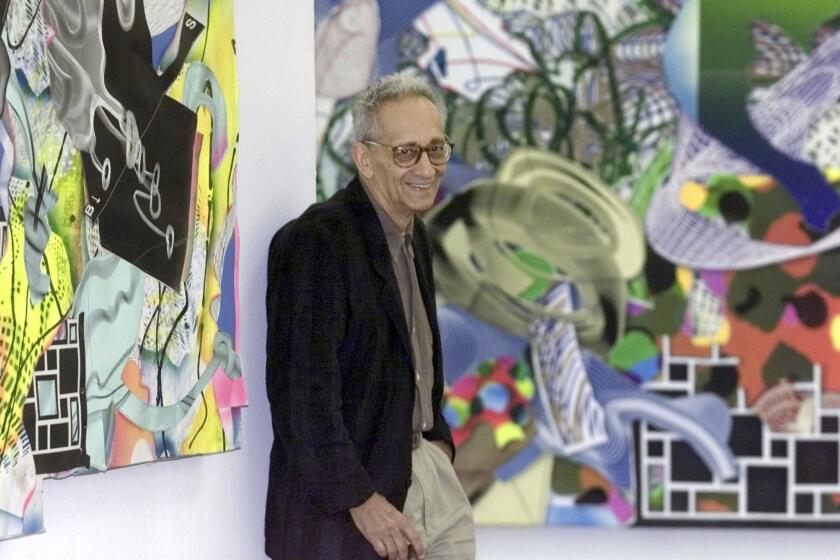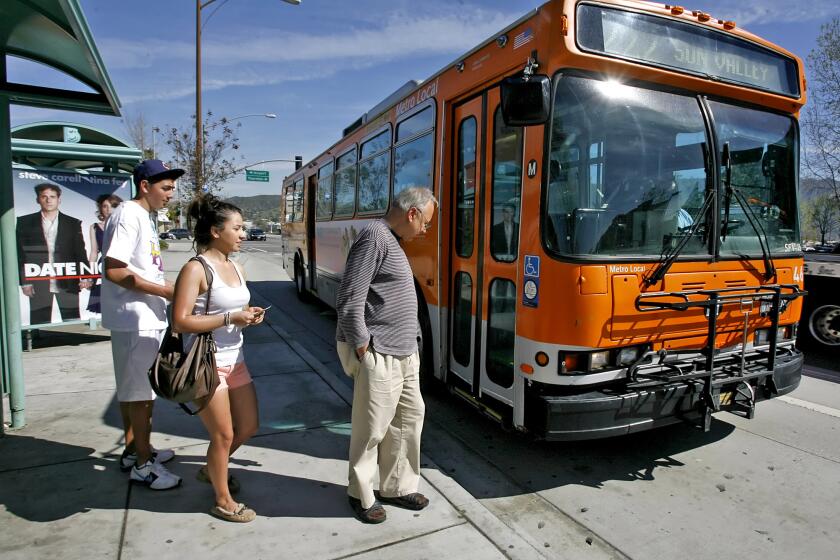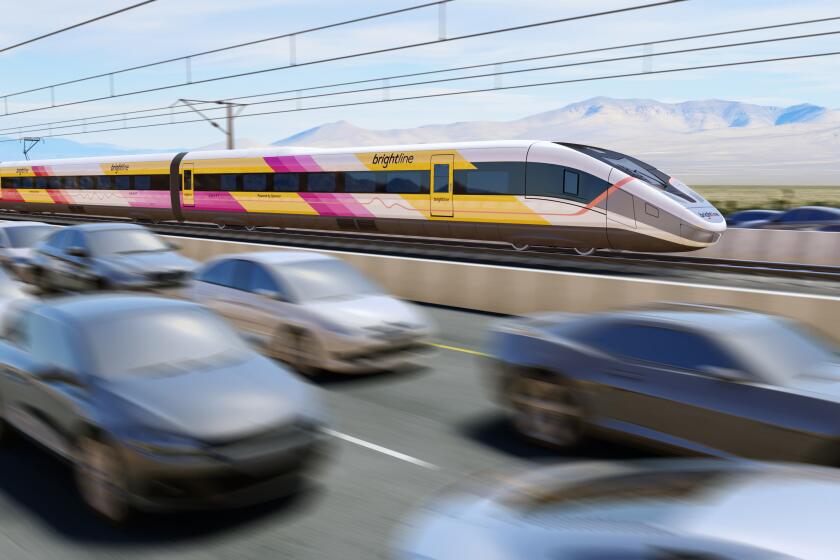Flashy Art, Flashy Town
On an otherwise gritty corner of East Hollywood, a shiny steel structure slants skyward at a 45-degree angle. The almond-shaped wedge dramatically reaches 30 feet above the sidewalk.
Is it some rocket ship about to be launched from the intersection of Santa Monica Boulevard and Vermont Avenue? Is it an art project by students from nearby Los Angeles City College? Is it a movie set for the next sci-fi blockbuster?
Actually, the stainless steel ellipse is the canopy over the entrance to an as-yet-unfinished Red Line subway station. Although the trains won’t be running below ground there and at four other stations in Hollywood until at least May, above-ground features already are transforming streetscapes. They also are attracting notice and raising questions from passersby.
And that is just what officials at the beleaguered Metropolitan Transportation Authority and its cadre of architects and artists want. Some riders complain that it is difficult to find Red Line stations downtown and along Wilshire Boulevard. So, for the Hollywood extension, the MTA is building street-level plazas that can’t be ignored, for better or worse.
“The question is: How do you make a presence on the street?” said Maya Emsden, director of the MTA’s public art program. “We need some way to draw attention to where you go into the system.”
The draw at Hollywood Boulevard and Vine Street is a collection of cartoon-like sculptures doubling as bus shelters. Designed by artist Gilbert “Magu” Lujan, they depict Los Angeles icons on stilts: a Brown Derby, a tiny Chinese Theatre, a white low-rider limousine. The elevator entrance, complete with a marquee, resembles a hodgepodge of movie palaces from the ‘20s.
“It looks like an amusement park waiting to open,” said Mark Newman, a Westside resident who was buying concert tickets at a box office across the street. “I think it is a great motif for the Hollywood area.”
But then there are people like Robert Nudelman, who derided the plaza as resembling a miniature golf course. “The MTA may call it whimsical, but I think it looks childish,” said the vice president of the Hollywood Heritage organization. “You expect something at Hollywood and Vine to be more impressive.”
Such debate is expected about all the plazas and the even more ambitiously designed stations below ground, said Maureen Tamuri, who was the MTA’s lead architect on the Hollywood extension project. “For everyone who doesn’t like one, I bet I can find someone who thinks it’s the cat’s meow,” she said.
The plazas, she added, are meant to symbolize that the most disruptive construction is over and to entice riders to try the subway. Tamuri acknowledges that the MTA has to overcome anger among taxpayers unhappy with the cost of the project, and among residents who have suffered through years of tunneling.
The overall cost of the 6.7-mile subway extension from the Westlake district to Hollywood and Vine is expected to be $1.647 billion, including three stations already open and the five being readied for their May debut, according to the MTA. The agency is spending about $4.3 million to decorate, landscape, pave and light the five above-ground station plazas along Vermont Avenue and Sunset and Hollywood boulevards.
Three Red Line stations are scheduled to open in 2000 at Hollywood Boulevard and Highland Avenue, and in Universal City and North Hollywood.
Parts of the plazas, particularly the large gardens, are planned to be temporary.
The MTA hopes the sites will one day include shops, housing or office complexes linked to Metro Rail stations. Developers have expressed little interest so far except in the case of the massive retail and theater complex proposed at Hollywood and Highland. So although the Brown Derby bus shelter might be moved and the cactus collection at Hollywood and Western Avenue might be ripped out, no such changes are imminent.
The futuristic canopy at Santa Monica and Vermont is to be a permanent fixture even if shops are one day built on the surrounding red-brick plaza.
Since the subway is a newcomer to East Hollywood, architect Mehrdad Yazdani wanted to build something clearly noticeable from cars and buses that would “tap into people’s curiosity and say that there is something exciting here to experience.” His flying wedge and the adjacent glass elevator cab in the shape of a trapezoid are both meant to connote speedy travel.
In 1992, six years before the artwork was erected, that design won a coveted citation from Progressive Architecture magazine. Now dramatically lighted at night, the canopy evokes mixed neighborhood reaction, affected in part by bad relations with the MTA.
Aldo Jarillo, a supervisor at the Campus Cinema just across the street, said he admires the wedge from his popcorn counter and ticket booth. “It looks like a space station, from science fiction. Something from ‘The Jetsons,’ ” he said. Yet he stressed that the subway’s efficiency will be more important than its looks.
Less pleased is Tessie Serna, owner of the nearby Betsy’s Bakery. Subway tunneling caused her business to drop by half, and she has filed financial claims against the MTA. “What is that?” she asked bitterly about the steel structure. “I don’t know. I have no idea.”
Enlivening a depressed neighborhood was a goal of artist May Sun, who helped design the Hollywood and Western station. The playful-looking elevator cab and the air shaft structure are covered with multicolored tiles that symbolize the multiethnic district.
“I think it does bring an energy to that site,” said Sun.
Plaza work is continuing at Beverly Boulevard and Vermont, where a cliff of simulated rock is being built up from the station to suggest rugged excavation. At Sunset and Vermont, an elevator cab will be reminiscent of the nearby Griffith Park Observatory.
At the Universal City station, designs call for a street-level elevator entrance with exterior columns that echo a now-lost grove.
Now the public can inspect the Hollywood plazas through chain-link fences. Emsden, the MTA public art director, said she looks forward to the day when people will sit beneath the limousine and Brown Derby. “I love the idea,” she said, “that someone is going to have a discussion under those bus shelters about whether they are right or wrong.”
More to Read
The biggest entertainment stories
Get our big stories about Hollywood, film, television, music, arts, culture and more right in your inbox as soon as they publish.
You may occasionally receive promotional content from the Los Angeles Times.







